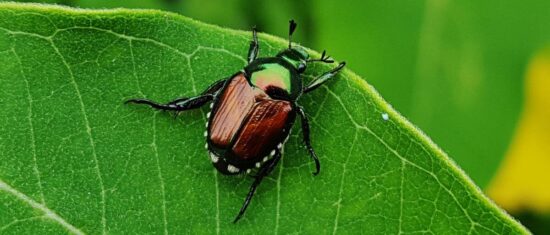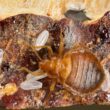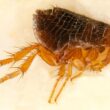Have you ever noticed how Japanese beetles seem to vanish when the sun goes down? One minute your garden is crawling with these shiny, copper-colored pests munching on your roses, and the next minute they’re nowhere to be found. So where Japanese beetles go at night has puzzled many gardeners who want to understand these destructive invaders better.
The truth is, Japanese beetles don’t really disappear at night. They just become much sneakier about where they hang out. Understanding their nighttime habits can actually help you fight back against these garden destroyers more effectively.
Why Japanese Beetles Change Their Behavior at Night
Japanese beetles are basically solar-powered insects. They love warm, sunny weather and become much less active when temperatures drop. Think of them like tiny reptiles that need heat to function properly.
These beetles have internal body clocks, just like humans do. Scientists call these circadian rhythms, which is just a fancy way of saying their bodies know when it’s day and night. When evening arrives and temperatures start cooling down, their entire behavior pattern shifts.
Temperature Controls Everything
Temperature is the biggest factor that determines where Japanese beetles go at night. When the air temperature drops below 70°F, these beetles start looking for cozy spots to wait out the cooler hours. They become sluggish and move much more slowly, which is actually great news for gardeners who want to remove them by hand.
Most Japanese beetles are most active when temperatures reach 84 to 95°F. Once it gets cooler than about 70°F, they start slowing down significantly. By the time temperatures hit the mid-60s, they’re barely moving at all.
The Three Main Places Japanese Beetles Hide at Night
When darkness falls, Japanese beetles head to three main types of hiding spots. Each location serves a specific purpose in helping them survive until morning.
Underground Hideouts
The most common answer to where Japanese beetles go at night is underground. These beetles are surprisingly good diggers for their size. They burrow into the soil, usually just 2 to 3 inches deep, creating small tunnel systems near their favorite plants.
You might notice tiny holes in your garden soil, especially near plants that have been heavily damaged. These are often the entrance points to beetle hideouts. The beetles choose spots with moist soil because it’s easier to dig and provides the humidity they need to stay healthy.
Female beetles are especially likely to burrow underground at night because they’re often looking for good spots to lay their eggs. They prefer well-watered areas like irrigated lawns and garden beds.
Vegetation Shelters
Many Japanese beetles spend their nights hiding in plants rather than underground. They crawl under leaves, nestle into thick bushes, or cluster together on tree branches. This behavior is like a sleepover party where safety comes in numbers.
Beetles particularly love hiding on the undersides of leaves. This spot protects them from dew, rain, and predators like birds that might be hunting in the early morning hours. Dense shrubs and ornamental grasses make perfect beetle hotels because they provide lots of hiding spots and protection from wind.
When beetles cluster together, they create their own little microclimate that stays warmer and more humid than the surrounding air. This group behavior helps them conserve energy and stay comfortable during cooler nights.
Light Source Attractions
Surprisingly, some Japanese beetles are attracted to artificial lights at night, even though they’re most active during the day. This might seem contradictory, but it happens because their navigation systems get confused by human-made lighting.
Streetlights, porch lights, and even bright security lights can draw beetles away from their normal hiding spots. They seem to prefer lights that give off blue or ultraviolet wavelengths, while yellow and red lights are less attractive to them.
This light attraction can actually work in your favor. If you notice beetles gathering around outdoor lights, it might be easier to collect them there rather than hunting through your plants.
What Japanese Beetles Actually Do All Night
Understanding where Japanese beetles go at night is only part of the story. What they do in these hiding spots is equally important for gardeners trying to control them.
Limited Nighttime Snacking
While Japanese beetles dramatically reduce their feeding at night, they don’t stop eating entirely. If temperatures stay above 60°F, some beetles will continue nibbling on plants throughout the night, just much more slowly than during the day.
Evening feeding can actually be quite substantial. Research shows that beetles often continue eating heavily until about 10 PM, especially on warm summer nights. This extended feeding time means your plants are taking damage for longer than you might realize.
The good news is that nighttime feeding is usually much lighter than daytime damage. Beetles save their biggest appetites for those hot, sunny afternoon hours when they can really chow down.
Romance in the Dark
Nighttime is actually prime time for Japanese beetle dating. Female beetles release special chemical signals called pheromones during evening hours to attract males. These scents can travel surprisingly far and draw male beetles from quite a distance.
This mating activity means that even if you remove all the beetles from your garden during the day, new ones might fly in overnight for romantic encounters. It’s one reason why beetle populations can seem to bounce back so quickly after you think you’ve gotten rid of them.
Getting Ready for Tomorrow
Much of what beetles do at night involves preparing for the next day’s activities. They’re positioning themselves near food sources, finding safe spots to rest, and conserving energy for another day of garden destruction.
Beetles also spend time grooming and maintaining their bodies during these quieter hours. Clean antennae and functioning wings are essential for finding food and mates the next day.
Using Nighttime Behavior to Fight Back
Knowing where Japanese beetles go at night gives you several advantages in the battle for your garden. You can use their predictable behavior patterns to make your control efforts more effective.
Perfect Timing for Hand Removal
Early morning, right after sunrise, is absolutely the best time to remove Japanese beetles by hand. They’re still sluggish from the cool nighttime temperatures and haven’t warmed up enough to fly away quickly.
During these early hours, you can literally shake beetles off plants into a bucket of soapy water. They’ll fall right off instead of flying away like they do during warmer parts of the day. This method works especially well when morning temperatures are still below 75°F.
Strategic Garden Lighting
You can manipulate beetle behavior by being smart about outdoor lighting. If you need security or landscape lighting, choose yellow or red LED bulbs instead of white or blue ones. This reduces the chance of accidentally attracting more beetles to your property.
Some gardeners even use this light attraction to their advantage by setting up beetle traps with specific types of bulbs placed away from valuable plants.
Habitat Modifications
Since you now know where Japanese beetles go at night, you can make your garden less appealing for their overnight stays. Reduce irrigation in areas where you’ve seen heavy beetle damage, especially during egg-laying season in mid-summer.
Remove dense ground cover and mulch from around your most valuable plants. While this might not look as nice, it eliminates the cozy hiding spots that beetles love. You can replant these areas with plants that beetles don’t like to eat.
Temperature Tricks and Timing
Japanese beetles are incredibly predictable when it comes to temperature. You can use this to your advantage by timing your garden activities around their behavior patterns.
Morning Collection Strategy
The absolute best time to collect beetles is during the first hour after sunrise when temperatures are still cool. Beetles will be clustered in their overnight hiding spots and moving very slowly. They literally can’t escape quickly because their flight muscles don’t work well in cool temperatures.
Bring a bucket of soapy water and simply knock beetles into it. They’ll drop right off plants instead of flying away. This method can remove dozens of beetles in just a few minutes when timed correctly.
Weather-Based Predictions
You can actually predict how active beetles will be by checking the weather forecast. Cool, cloudy days mean beetles will be sluggish and easier to manage. Hot, sunny days mean they’ll be at their most destructive and hardest to catch.
Plan your beetle removal activities for cooler mornings or evenings when possible. Save other garden tasks for the times when beetles are most active and hardest to deal with.
The Science Behind Their Night Vision
Japanese beetles have surprisingly complex eyes that work differently in bright light versus darkness. Understanding this helps explain some of their nighttime behavior choices.
How Beetle Eyes Work
Beetle eyes are made up of thousands of tiny lenses, kind of like a honeycomb pattern. During the day, each lens works independently to create a detailed picture. At night, their eyes can combine light from multiple lenses to see better in darkness, but this makes their vision much blurrier.
This change in vision quality is one reason why beetles prefer to hide in familiar spots at night rather than wandering around looking for new food sources. They simply can’t see well enough to navigate safely in the dark.
Light Confusion Problems
The beetle’s natural navigation system evolved to use the moon and stars for direction. Artificial lights confuse this system because they’re much brighter and closer than natural light sources. This is why you might see beetles flying in circles around porch lights or streetlights.
This light confusion can actually help with beetle control. Beetles that get trapped in these light circles are often exhausted by morning and easier to collect.
Seasonal Changes in Night Behavior
Where Japanese beetles go at night changes somewhat throughout their active season, which typically runs from June through September in most areas.
Early Season Patterns
When beetles first emerge in June, they spend more time underground at night because they’re still building up their energy reserves. They’ve just finished transforming from grubs into adult beetles and need time to strengthen their flight muscles.
During this early period, you’ll find most beetles within a few inches of the soil surface, often near the same plants where they emerged as grubs.
Peak Season Activity
July and August represent peak beetle season, and this is when their nighttime behavior becomes most varied. Some beetles are underground, others are in vegetation, and many are actively flying around looking for mates and new food sources.
This is also when the light attraction behavior is most noticeable. Warm summer nights mean beetles stay active longer and are more likely to be drawn to artificial lighting.
Late Season Preparation
As September arrives and temperatures start cooling, beetles spend more time in underground shelters. They’re preparing for the end of their life cycle and focusing on mating and egg-laying activities.
Late-season beetles often choose deeper hiding spots and stay hidden for longer periods. This makes them harder to find but also means they’re doing less damage to plants.
Common Mistakes in Beetle Management
Understanding where Japanese beetles go at night helps avoid some common mistakes that actually make beetle problems worse.
Trap Placement Problems
Many people place Japanese beetle traps too close to valuable plants. Since beetles are attracted to these traps from quite a distance, poor placement can actually draw more beetles into your garden than you remove.
Place traps at least 30 feet away from plants you want to protect, and consider the wind direction since beetle pheromones can travel on air currents.
Timing Treatment Wrong
Applying insecticides during peak daytime hours when beetles are most active often means you’re treating empty plants. Many beetles are hidden underground or in vegetation during treatment times.
Early morning or evening applications, when beetles are in their hiding spots, can be much more effective. You’re treating the areas where beetles actually are, not just where they feed.
Ignoring Underground Populations
Many gardeners focus only on the beetles they can see on plants and ignore the underground populations. But remember, a significant portion of your beetle problem might be hiding just inches under your feet.
Consider treatments that target underground hiding spots, especially in areas with moist soil near heavily damaged plants.
Creating a Beetle-Unfriendly Night Environment
You can modify your garden environment to make it less appealing for nighttime beetle activities without harming beneficial insects or plants.
Moisture Management
Since beetles prefer moist soil for nighttime burrowing, strategic watering can help reduce their overnight populations. Water deeply but less frequently to avoid creating the constantly moist conditions beetles love.
Focus irrigation on plant root zones rather than surface watering that creates ideal beetle habitat. Drip irrigation systems work better than sprinklers for this purpose.
Physical Barriers
Row covers or fine mesh can protect valuable plants during peak beetle season. Since beetles choose their overnight hiding spots based on proximity to food sources, blocking access to preferred plants forces them to look elsewhere.
Remove covers during early morning hours when you want to collect beetles, then replace them for overnight protection.
Natural Predator Support
Many beetle predators are active at night, including spiders, ground beetles, and some birds. Maintaining habitat for these beneficial creatures can help control beetle populations naturally.
Avoid broad-spectrum insecticide treatments that kill beneficial predators along with Japanese beetles. Instead, focus on targeted removal methods that preserve the good guys.
Planning Your Anti-Beetle Strategy
Now that you understand where Japanese beetles go at night, you can develop a comprehensive management plan that works with their natural behavior patterns instead of against them.
Daily Monitoring Routine
Check your garden at the same time each morning, preferably within an hour of sunrise. Look for new damage and note where beetles are clustering. This information helps you predict where they’ll hide the following night.
Keep a simple log of beetle numbers and damage levels. This helps you track whether your control methods are working and adjust your strategy accordingly.
Seasonal Planning
Plan your garden layout with beetle behavior in mind. Place the most susceptible plants in areas where you can easily access them for early morning beetle removal. Group resistant plants in areas where you’re willing to tolerate some beetle presence.
Consider the timing of plant bloom periods. Some plants are only attractive to beetles when flowering, so you can plan protection strategies around these specific time periods.
Understanding where Japanese beetles go at night isn’t just interesting trivia. It’s practical knowledge that can make your pest control efforts much more effective and help you reclaim your garden from these destructive invaders. By working with their natural behavior patterns, you can outsmart these shiny pests and keep your plants healthier all season long.


